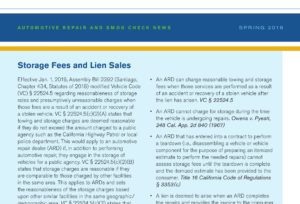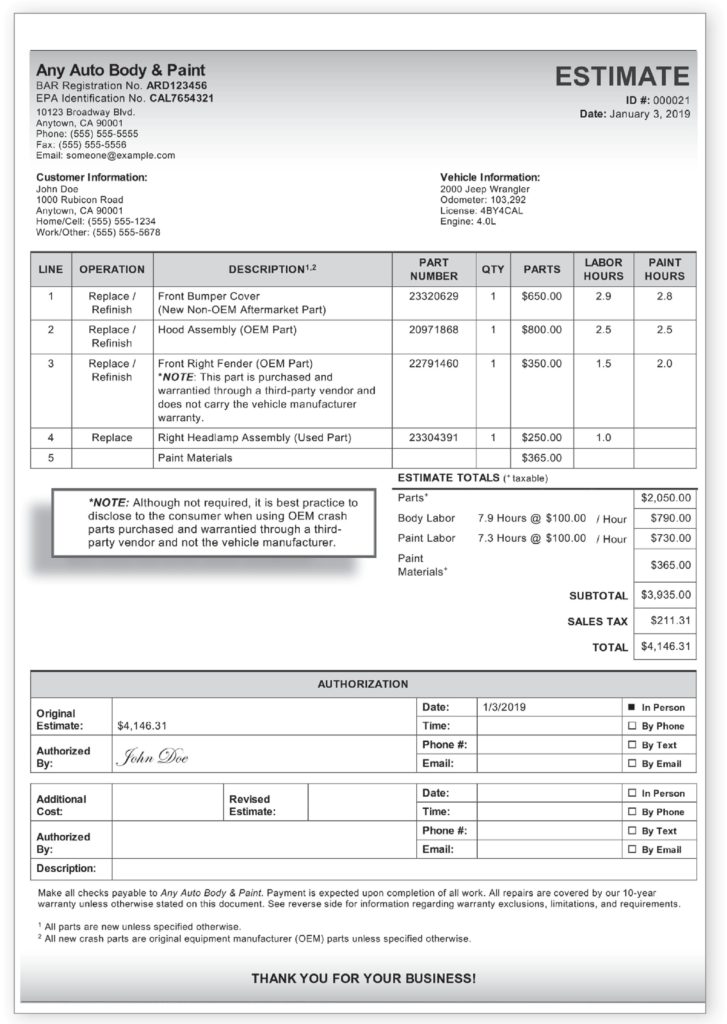
Calif. BAR newsletter spells out view on storage fees, ‘non-OEM’ vs. ‘OEM’ parts
By onBusiness Practices | Legal | Market Trends | Repair Operations
California collision repairers and insurers received further clarity from the Bureau of Automotive Repair on storage and part identification with the recent publication of the agency’s spring 2019 newsletter.
The agency’s guidance — in writing — ought to help settle some disputes and offer some direction to regulators, insurers, vendors and repairers mulling these issues in other states.
Storage
The BAR’s article on storage echoed operations branch program manager Matthew Gibson’s recent presentation to a California Autobody Association chapter. Gibson said he had discussed his assessment with California Department of Insurance Deputy Commissioner Tony Cignarale.
“VC § 22524.5(c)(2)(A) states that towing and storage charges are deemed reasonable if they do not exceed the amount charged to a public agency such as the California Highway Patrol or local police department,” the BAR wrote in the newsletter. “This would apply to an automotive repair dealer (ARD) if, in addition to performing automotive repair, they engage in the storage of vehicles for a public agency. VC § 22524.5(c)(2)(B) states that storage charges are reasonable if they are comparable to those charged by other facilities in the same area. This applies to ARDs and sets the reasonableness of the storage charges based upon other similar facilities in the same geographic/ demographic area.” (Emphasis added.)
Essentially, if your body shop doesn’t store vehicles under a deal with a government agency as a traditional tow/storage yard would, then you fall under B. Insurers (or customers, presumably) must pay you whatever is reasonable based on facilities in your area.
“This does not preclude a rate or fee that is higher or lower if it is otherwise reasonable,” Part B also states.
The BAR also helped body shops figure out when storage fees or a lien would be appropriate by summing up a series of rules and one court precedent.
Three critical ones to remember (emphasis BAR’s; minor formatting edits):
• An ARD cannot charge for storage during the time the vehicle is undergoing repairs. Owens v. Pyeatt, 248 Cal. App. 2d 840 (1967)
• An ARD that has entered into a contract to perform a teardown (i.e., disassembling a vehicle or vehicle component for the purpose of preparing an itemized estimate to perform the needed repairs) cannot assess storage fees until the teardown is complete and the itemized estimate has been provided to the consumer. Title 16 California Code of Regulations § 3353(c)
• A lien is deemed to arise when an ARD completes the repairs and provides the invoice to the consumer, or 15 days after the completion of repairs, whichever occurs first. An ARD has 30 days after the lien has arisen to apply with the Department of Motor Vehicles (DMV) for authorization to conduct a lien sale. Civil Code (CC) §§ 3068(a) and (b)
Remember, the BAR views the vehicle owner as your customer, not the insurer.
‘OEM’ parts
BAR and CDI shook up repairers, insurers and vendors last year by agreeing that repairers couldn’t use terms to describe parts outside of those permitted under California regulations. For example, an ostensibly OEM part supplied outside of the automaker’s official channel couldn’t be called “Opt-OE.”
BAR in the newsletter sought to get all auto repair dealers up to speed on what the agency has said in response to various inquiries on the topic.
“Crash parts” are governed by 16 CCR 3303, which states:
(o) “Crash part” means a replacement for any of the non-mechanical sheet metal or plastic parts which generally constitute the exterior of a motor vehicle, including inner and outer panels.
(p) “Original Equipment Manufacturer crash part” or “OEM crash part” means a crash part made for or by the original vehicle manufacturer that manufactured, fabricated or supplied a vehicle or a component part.
(q) “Non-Original Equipment Manufacturer aftermarket crash part” or “non-OEM aftermarket crash part” means aftermarket crash parts not made for or by the manufacturer of the motor vehicle.
The BAR is examining tightening up the definition of “OEM crash part” to exclude parts not recognized by the automaker or sold through the official authorized channel. It also might add “bonded glass” to the category of “crash part.”
But for now, repairers are held to the current language and BAR’s interpretation of it. Shops are also governed by Business and Professions Code 9884.9, which says they must identify parts as “new, used, rebuilt, or reconditioned.”
“BAR regulates ARDs and does not have specific jurisdiction over vendors of automotive parts,” the BAR wrote in the newsletter. “It is the responsibility of each BAR-registered ARD to determine whether the new crash parts used to repair a consumer’s vehicle meet the definition of OEM or non-OEM aftermarket. Additionally, the ARD is required to provide the consumer with both an estimate and an invoice that properly describe all parts, including OEM and non-OEM aftermarket crash parts, used during the repair of the vehicle.
“BAR does not have regulations addressing crash part warranties, including those sold by third-party vendors. BAR’s crash part definitions do not include a part’s newness, packaging, seller, or warranty provider. As a consumer protection agency, BAR educates ARDs on the importance of clear communication, including the consumer’s right to make an informed decision about the repairs they authorize. It is critical that ARDs understand their role in ensuring consumers are not misled. They can be held liable for any false or misleading statements that cannot be supported and are done with the intent to deceive the consumer. BAR acknowledges that some vehicle manufacturers recognize certain third-party vendors as suppliers of their OEM parts, but others may not, which underscores the importance of ARDs doing their research.”
The new “Write it Right” update in February 2019 offers a sample estimate which the BAR newsletter says gives “clear information to the consumer about whether crash parts are OEM or non-OEM aftermarket, the supplier of the parts, and warranty information.”

More information:
Automotive Repair and Smog Check News, Spring 2019
Automotive Repair and Smog Check News, Spring 2019
California Bureau of Automotive Repair, February 2019
Featured image: California collision repairers and insurers received further clarity from the Bureau of Automotive Repair on storage and part identification with the recent publication of the agency’s spring 2019 newsletter. (Provided by BAR)
